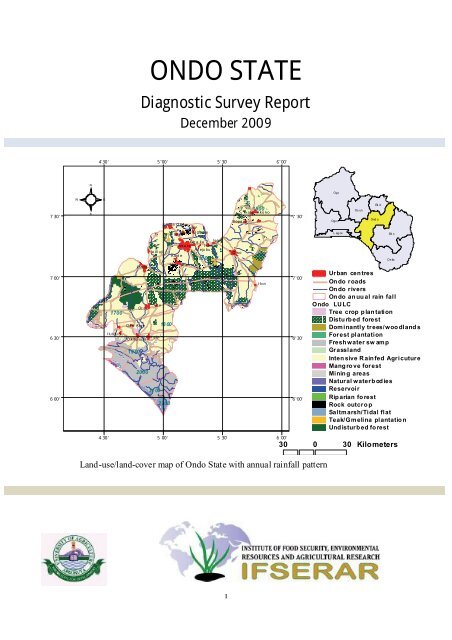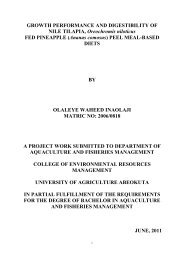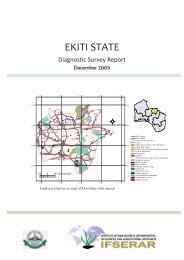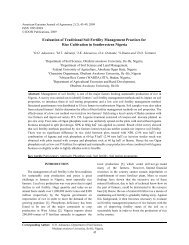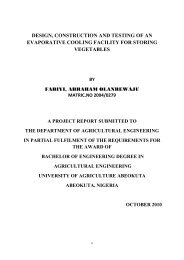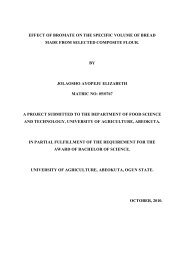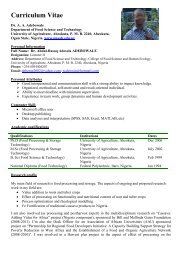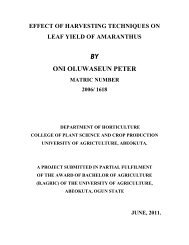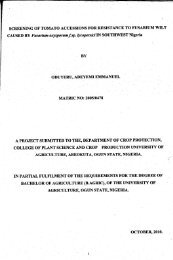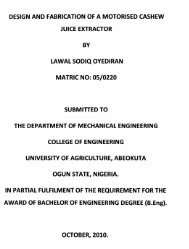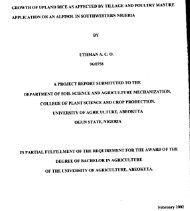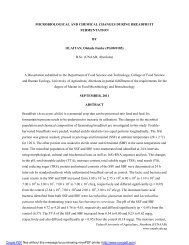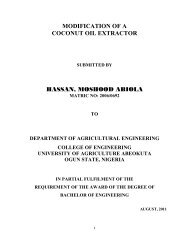ONDO STATE - The Federal University of Agriculture, Abeokuta
ONDO STATE - The Federal University of Agriculture, Abeokuta
ONDO STATE - The Federal University of Agriculture, Abeokuta
Create successful ePaper yourself
Turn your PDF publications into a flip-book with our unique Google optimized e-Paper software.
<strong>ONDO</strong> <strong>STATE</strong><br />
Diagnostic Survey Report<br />
December 2009<br />
4 30'<br />
5 00'<br />
5 30'<br />
6 00'<br />
N<br />
W<br />
E<br />
1500<br />
S<br />
Ikare A ko ko<br />
7 30' 7 30'<br />
S opa re<br />
Ig bara O ke<br />
Ij u<br />
Ila raIja reIta O gb ol u<br />
1700<br />
19 00<br />
O ndo<br />
Or e<br />
2000<br />
Ile ol uji<br />
Otu<br />
21 00<br />
18 00<br />
A lad e<br />
Ob a Il e Iso<br />
A ku re Isho<br />
Ad eju bu<br />
7 00' 7 00'<br />
Ifon<br />
Od e Ai ye<br />
Iluti tu n<br />
6 30' Ir ele<br />
O kitip up a<br />
6 30'<br />
6 00' 6 00'<br />
2200<br />
4 30'<br />
5 00'<br />
Id an re<br />
16 00<br />
Land-use/land-cover map <strong>of</strong> Ondo State with annual rainfall pattern<br />
5 30'<br />
O wo<br />
6 00'<br />
Oyo<br />
Ogu n<br />
L ag os<br />
Os un<br />
Ek iti<br />
Ond o<br />
Urban cen tres<br />
On do roads<br />
On do rivers<br />
On do an uu al rain fall<br />
Ondo LU LC<br />
Tree crop p lan tation<br />
Distu rb ed forest<br />
Dominantly trees/woo dland s<br />
Forest plantation<br />
Fresh water sw amp<br />
Grassland<br />
Inten sive R ain fed Agricuture<br />
Mang ro ve forest<br />
Minin g areas<br />
Natural waterb od ies<br />
Reservoir<br />
Rip arian fo rest<br />
Rock outcro p<br />
Saltmarsh/Tidal flat<br />
Teak/Gmelina plantatio n<br />
Und isturb ed fo rest<br />
30 0 30 Kilometers<br />
Ed o<br />
De lta<br />
i
<strong>ONDO</strong> <strong>STATE</strong><br />
Diagnostic Survey Report<br />
December 2009<br />
ii
© UNAAB-IFSERAR, 2010<br />
ISBN 978-978-50092-1-7<br />
<strong>ONDO</strong> <strong>STATE</strong><br />
Diagnostic Survey Report<br />
December 2009<br />
Published by:<br />
Institute <strong>of</strong> Food Security, Environmental Resources and Agricultural Research<br />
<strong>University</strong> <strong>of</strong> <strong>Agriculture</strong><br />
P.M.B. 2240<br />
<strong>Abeokuta</strong><br />
Nigeria<br />
Tel.: +2348064779102<br />
e-mail: ifserar.unaab@yahoo.com<br />
website: www.unaab.edu.ng/ifserar<br />
iii
UNIVERSITY OF AGRICULTURE,<br />
ABEOKUTA<br />
DIAGNOSTIC SURVEY REPORT OF <strong>ONDO</strong> <strong>STATE</strong><br />
AGRICULTURAL PRODUCTION<br />
12/1/2009<br />
DR. J.O. DARAMOLA, DR. M.F. ADEKUNLE<br />
DR. M.O. OLANIYI, MRS. F.M. ALAYAKI<br />
iv<br />
iv
TABLE OF CONTENTS<br />
Cover Page.................................................................................................................. iv<br />
Table <strong>of</strong> Contents........................................................................................................ v<br />
viii<br />
Preamble..................................................................................................................... 1<br />
1.0 Introduction to Research Diagonistic Survey................................................. 1<br />
1.1 Research Objectives........................................................................................ 2<br />
2.0 Method <strong>of</strong> Study and Data Collection............................................................ 2<br />
2.1 Study Area...................................................................................................... 2<br />
2.2 Sampling and Data Collection........................................................................ 5<br />
3.0 Diagnostic Survey <strong>of</strong> Focus Groups............................................................... 5<br />
3.1 Owo Zone........................................................................................................ 5<br />
3.1.1 Igisogba Focus Group..................................................................................... 5<br />
A. Farmer Characteristics.................................................................................... 5<br />
B. Crop/Livestock................................................................................................ 6<br />
C. Post-Harvest Activities................................................................................... 7<br />
D. Constraints/Problems in <strong>Agriculture</strong>............................................................... 7<br />
E. Interventions................................................................................................... 7<br />
3.1.2 Uso Focus Group............................................................................................ 7<br />
A. Farmer Characteristics..................................................................................... 7<br />
B. Crop/Livestock................................................................................................ 8<br />
C. Post-Harvest Activities................................................................................... 8<br />
D. Constraints/Problems in <strong>Agriculture</strong>............................................................... 9<br />
E. Interventions................................................................................................... 9<br />
3.1.3 Isuada Focus Group........................................................................................ 9<br />
A. Farmer Characteristics..................................................................................... 9<br />
B. Crop/Livestock................................................................................................ 10<br />
C. Post Harvest Activities.................................................................................... 10<br />
D. Constraints/Problems in <strong>Agriculture</strong>............................................................... 10<br />
E. Interventions.................................................................................................... 11<br />
3.1.4 Emure-Ile Focus Group................................................................................... 11<br />
A. Farmer Characteristics..................................................................................... 11<br />
v
B. Crop/Livestock................................................................................................ 12<br />
C. Post-Harvest Activities................................................................................... 12<br />
D. Constraints/Problems in <strong>Agriculture</strong>............................................................... 12<br />
E. Interventions................................................................................................... 12<br />
3.1.5 Oba-Akoko Focus Group................................................................................ 13<br />
A. Farmer Characteristics..................................................................................... 13<br />
B. Crop/Livestock................................................................................................ 13<br />
C. Post-Harvest Activities................................................................................... 14<br />
D. Constraints/Problems in <strong>Agriculture</strong>............................................................... 14<br />
E. Interventions................................................................................................... 14<br />
3.2. Ondo Zone...................................................................................................... 14<br />
3.2.1 Okitipupa Focus Group................................................................................... 14<br />
A. Farmer Characteristics..................................................................................... 15<br />
B. Crop/Livestock................................................................................................ 15<br />
C. Post-Harvest Activities................................................................................... 16<br />
D. Constraints/Problems in <strong>Agriculture</strong>............................................................... 16<br />
E. Interventions................................................................................................... 16<br />
3.2.2 Okoga Focus Group........................................................................................ 17<br />
A. Farmer Characteristics..................................................................................... 17<br />
B. Crop/Livestock................................................................................................ 17<br />
C. Post-Harvest Activities................................................................................... 18<br />
D. Constraints/Problems in <strong>Agriculture</strong>............................................................... 18<br />
E. Interventions.................................................................................................... 18<br />
3.2.3 Oloruntele Focus Group.................................................................................. 18<br />
A. Farmer Characteristics..................................................................................... 18<br />
B. Crop/Livestock................................................................................................ 19<br />
C. Post-Harvest Activities................................................................................... 19<br />
D. Constraints/Problems in <strong>Agriculture</strong>............................................................... 20<br />
E. Interventions................................................................................................... 20<br />
3.2.4 Wasimi Focus Group...................................................................................... 20<br />
A. Farmer Characteristics..................................................................................... 20<br />
B. Crop/Livestock................................................................................................ 21<br />
C. Post-Harvest Activities................................................................................... 21<br />
D. Constraints/Problems in <strong>Agriculture</strong>............................................................... 21<br />
vi
E. Interventions...................................................................................................... 21<br />
3.2.5 Obajare (Idanre) Focus Group........................................................................ 22<br />
A. Farmer Characteristics.............................................................................. 22<br />
B. Crop/Livestock............................................................................................ 22<br />
C. Post-Harvest Activities................................................................................ 23<br />
D. Constraints/Problems In <strong>Agriculture</strong>........................................................ 23<br />
E. Interventions................................................................................................ 23<br />
4.0 Diagnostic Survey <strong>of</strong> the Contact Institutions in Ondo State......................... 23<br />
4.1 Ondo State Agricultural Development Project (Odsadep)............................... 24<br />
4.1.1 Interventions................................................................................................... 24<br />
4.1.2 Constraints/Problems in <strong>Agriculture</strong>............................................................... 25<br />
4.1.3 Recommendations / Suggestions.................................................................... 25<br />
4.2 Ondo State Ministry <strong>of</strong> <strong>Agriculture</strong>, Fisheries and Forest Resources 25<br />
4.2.1 Interventions................................................................................................... 26<br />
4.2.2 Constraints/Problems in <strong>Agriculture</strong>............................................................... 27<br />
4.2.3 Recommendations/Suggestions...................................................................... 27<br />
Conclusion.................................................................................................................. 28<br />
Acknowledgement...................................................................................................... 28<br />
Appendices<br />
vii
LIST OF APPENDICES<br />
1. Ondo State Government Agricultural Policy (June, 2005)<br />
2. Population Density by States with Animal Rainfall Distribution Pattern<br />
3. Population Density by LGAs in Ondo State.<br />
4. Land use/Land-Cover map <strong>of</strong> Ondo State with annual rainfall pattern<br />
5. Driving direction for Ondo State<br />
6. Start Your Own Small Scale Enterprise Small Scale Rabbi Production oryctolagus<br />
cunuculus Agric Empowerment Series 8<br />
7. Start your Own Small Scale Enterprise Pig Production` Sus Scr<strong>of</strong>a domesticus<br />
8. Cucumber Production Cucuimis Sativa L<br />
9. Cassava/Maize/Mellon Crop Mixture<br />
10. Operations and Maintenance <strong>of</strong> Water Pump<br />
11. Tomato Package (ODSADEP<br />
12. Lowland Rice Package (ODSADEP)<br />
13. Package for leafy Vegetable (ODSADEP)<br />
14. Production <strong>of</strong> Seed Yam by Minisett Technique (ODSADEP)<br />
15. Information about Ministry <strong>of</strong> <strong>Agriculture</strong>, Fisheries and Forest Resources<br />
16. Okro Package (ODSADEP)<br />
17. Soyabean Package (ODSADEP)<br />
18. Cassava Package (ODSADEP)<br />
19. Ogbin Eree Soya (ODSADEP)<br />
20. Poultry Package (ODSADEP)<br />
21. Cocoyam Package (ODSADEP)<br />
22. Rice Package (ODSADEP)<br />
23. Cowpea Package (ODSADEP)<br />
24. Soya Bean Utilization (ODSADEP)<br />
25. HIV/ AIDS Extension Guide Prepared for the Agricultural Extension Workers and Other<br />
Rural Change Agents (August, 2008)<br />
viii
DIAGNOSTIC SURVEY REPORT OF <strong>ONDO</strong> <strong>STATE</strong> AGRICULTURAL<br />
PRODUCTION<br />
PREAMBLE<br />
A diagnostic survey on agricultural production in Ondo state which is one <strong>of</strong> the mandate<br />
states <strong>of</strong> <strong>University</strong> <strong>of</strong> <strong>Agriculture</strong>, <strong>Abeokuta</strong> was conducted in order to identify some areas<br />
<strong>of</strong> research and development intervention.<br />
1.0 INTRODUCTION TO RESEARCH DIAGONISTIC SURVEY<br />
Ondo State is predominantly an agricultural State with over 60% <strong>of</strong> its labour force deriving<br />
their income from farming. <strong>The</strong> State is richly blessed with varied and favourable ecological<br />
and climatological conditions with vegetation ranging from mangrove swamps <strong>of</strong> the<br />
southern coastal riverine areas through the rainforest <strong>of</strong> the midlands to the derived savannah<br />
in the northern part <strong>of</strong> the State. Thus the State can support the cultivation <strong>of</strong> a large variety<br />
<strong>of</strong> crops. <strong>The</strong> State also has the longest coastline in the country which favours fishing<br />
activities in the riverine areas.<br />
<strong>Agriculture</strong> (including fishing) constitutes the main occupation <strong>of</strong> the people <strong>of</strong> the state.<br />
Indeed, Ondo state is the leading cocoa producing state in Nigeria. Other agricultural<br />
products include yams, cassava and palm produce. Farming in the State is characterized by<br />
small farm sizes, inadequate supply <strong>of</strong> modern farming inputs, poor state <strong>of</strong> rural<br />
infrastructure, ageing farmers, significant post-harvest losses, dependence on rain for<br />
farming, and lack <strong>of</strong> interest among youths in agricultural activities.<br />
<strong>The</strong> ethnic composition <strong>of</strong> Ondo State is largely from the Yoruba subgroups <strong>of</strong> the Akoko,<br />
Akure, Ikale, Ilaje, Ondo, and Owo. Ijaw minority (such as Apoi and Arogbo) populations<br />
inhabit the coastal areas; while the Ife-speaking people <strong>of</strong> Oke-Igbo constitute another<br />
minority. Ondo State <strong>of</strong> Nigeria was one <strong>of</strong> the seven states created on 3rd February, 1976. It<br />
was carved out <strong>of</strong> the former Western State. Ondo State took <strong>of</strong>f formally on 1st April, 1976,<br />
consisting <strong>of</strong> the nine administrative divisions <strong>of</strong> the former Western State (Ministry <strong>of</strong><br />
Information and Culture, 1979). <strong>The</strong>se nine divisions then were Akoko, Akure, Ekiti Central,<br />
Ekiti North, Ekiti South, Ekiti West, Okitipupa, Ondo and Owo. Akure town ship was<br />
retained as the state headquarters. However, on 1st October, 1996, Ekiti State comprising<br />
1
Ekiti Central, Ekiti North, Ekiti South and Ekiti West Divisions was carved out <strong>of</strong> Ondo<br />
State. Hence, the present Ondo State is made up <strong>of</strong> Akoko, Akure, Okitipupa, Ondo and Owo<br />
Divisions.<br />
1.1 Research Objectives<br />
Specifically the study included the following objectives:<br />
1. Identify basic social and economic characteristic <strong>of</strong> the farmers.<br />
2. Identify the farm activities/enterprises and the common practices.<br />
3. Identify the basic problems/challenges in farming in the state.<br />
4. Identify the available /existing technologies in farming in the state.<br />
5. Describe the effects/roles <strong>of</strong> other institutions in the area on agriculture.<br />
6. Draw conclusion and action plan.<br />
2.0 RESEARCH METHODOLOGY<br />
2.1 Study Area<br />
Location: <strong>The</strong> state lies between latitudes 5 0 45' and 7 0 52'N and longitudes 4 0 20' and 6 0<br />
05'E. Its land area is about 15,500 square kilometers. Ondo State is bounded on the east by<br />
Edo and Delta states, on the west by Ogun and Osun States, on the north by Ekiti and Kogi<br />
States and to the south by the Bight <strong>of</strong> Benin and the Atlantic Ocean.<br />
Administrative Areas: <strong>The</strong> apex <strong>of</strong> the administrative structure is the state headquarters,<br />
Akure. Prior to the carving out <strong>of</strong> Ekiti State from Ondo State there were twenty-six Local<br />
Government Areas (LGAs). Fourteen <strong>of</strong> these remained in Ondo State, and from these,<br />
additional four LGAs were created. As at now, there are eighteen LGAs in Ondo State. An<br />
important aspect <strong>of</strong> the administrative setup <strong>of</strong> Ondo State is the recognition <strong>of</strong> four<br />
subordinate area authorities. <strong>The</strong>se are areas having some recognized autonomy within their<br />
LGAs.<br />
Major industries in Ondo State include Nigeria/Romania Wood Industries in Ondo; the<br />
Okitipupa Oil Palm Mill; Alpha Industries, Arigidi-Akoko; Cocoa Processing factory, Ile-<br />
Oluji; Oluwa Glass Company, Igbokoda and the Premier Metal Industry, Ondo.<br />
<strong>The</strong>re are two distinct geological regions in Ondo State. First, is the region <strong>of</strong> sedimentary<br />
rocks in the south, and secondly, the region <strong>of</strong> Precambrian Basement Complex rocks in the<br />
north. Some few kilometres north <strong>of</strong> Aaye occurs the basement complex sedimentary rocks<br />
2
oundary. <strong>The</strong> sedimentary rocks are mainly <strong>of</strong> the post Cretaceous sediments and the<br />
Cretaceous <strong>Abeokuta</strong> Formation. <strong>The</strong> basement complex is mainly <strong>of</strong> the medium grained<br />
gneisses. <strong>The</strong>se are strongly foliated rocks frequently occurring as out crops. On the surface<br />
<strong>of</strong> these outcrops, severely contorted, alternating bands <strong>of</strong> dark and light coloured minerals<br />
can be seen. <strong>The</strong>se bands <strong>of</strong> light coloured minerals are essentially feldspar and quartz, while<br />
the dark coloured bands contain abundant biotic mica. A small proportion <strong>of</strong> the state,<br />
especially to the northeast, overlies the coarse grained granites and gneisses, which are poor<br />
in dark ferromagnesian minerals.<br />
Ondo State is composed <strong>of</strong> lowlands and rugged hills with granitic outcrops in several places.<br />
In general, the land rises from the coastal part <strong>of</strong> llaje/Ese-Odo (less than fifteen meters above<br />
sea level) in the south, to the rugged hills <strong>of</strong> the north eastern portion in Akoko area. Some<br />
<strong>of</strong> the more prominent hills found at Idanre and Akoko rise above 250 meters above sea level.<br />
<strong>The</strong> geomorphologic units <strong>of</strong> the creek and riverine areas include sand ridges, lagoons,<br />
swamp flats, creeks and the anatomizing distributaries <strong>of</strong> the western Niger Delta. Numerous<br />
rivers flowing southwards to the Atlantic Ocean drain the state. <strong>The</strong>se rivers include the<br />
Owena, Oluwa, Oni, Ogbese and Ose. <strong>The</strong> most outstanding characteristics <strong>of</strong> the drainage<br />
systems over the areas <strong>of</strong> Basement Complex rocks is the proliferation <strong>of</strong> many small river<br />
channels. <strong>The</strong> channels <strong>of</strong> the smaller streams are dry for many months, especially from<br />
November to May. <strong>The</strong> major rivers flow through sedimentary rocks in deeply incised valleys<br />
aligned in a north-south direction, into the coastal lagoons. <strong>The</strong> lagoons flow in a west-east<br />
direction, parallel to the coast. Another aspect <strong>of</strong> the relief <strong>of</strong> Ondo State is the prevalence <strong>of</strong><br />
many erosion gullies along hill slopes. <strong>The</strong> gullies are very common and rather devastating<br />
in Owo and Akoko areas. Gullies also occur in areas <strong>of</strong> sedimentary rocks in Okiti-pupa and<br />
Araromi Rubber Estate. Along the Creeks, there are no sandy beaches since the entire area is<br />
swampy.<br />
Climate: <strong>The</strong> climate <strong>of</strong> Ondo State is <strong>of</strong> the Lowland Tropical Rain Forest type, with<br />
distinct wet and dry seasons. In the south, the mean monthly temperature is 27 0 C, with a<br />
mean monthly range <strong>of</strong> 2 0 C, while mean relative humidity is over seventy five percent (25%).<br />
However, in the northern part <strong>of</strong> the state, the mean monthly temperature and its range are<br />
about 30 0 C and 6 0 C respectively. <strong>The</strong> mean monthly relative humidity is less than seventy<br />
percent. In the south, rain falls throughout the year, but the three months <strong>of</strong> November,<br />
December and January may be relatively dry. <strong>The</strong> mean annual total rainfall exceeds 2000<br />
millimeters. However, in the north, there is marked dry season from November to March<br />
3
when little or no rain falls. <strong>The</strong> total annual rainfall in the north, therefore, drops considerably<br />
to about 1800 millimeters.<br />
Vegetation: <strong>The</strong> natural vegetation is the high forest, composed <strong>of</strong> many varieties <strong>of</strong><br />
hardwood timber such as Melicia excelsa, Antaris africana, Terminalia superba, Lophira<br />
procera and Symphonia globulifera. In the northern districts, the vegetation consists <strong>of</strong><br />
woody savanna featuring such tree species as Blighia sapida. <strong>The</strong> swamp flats are the domain<br />
<strong>of</strong> the fresh water swamp forests in the interior and the units <strong>of</strong> mangrove vegetation near the<br />
coast. <strong>The</strong> sand ridges are characterized by savanna and stunted rain forests. Over most <strong>of</strong> the<br />
state, the natural vegetation has been very much degraded as a result <strong>of</strong> human activities, the<br />
chief <strong>of</strong> which is based on the rotation <strong>of</strong> bush fallow system. As a result, the original forest<br />
is now restricted to forest reserves. An important aspect <strong>of</strong> the vegetation <strong>of</strong> the state is the<br />
prevalence <strong>of</strong> tree crops. <strong>The</strong> major tree crops include cocoa, kola, c<strong>of</strong>fee, rubber, oil palms<br />
and citrus, cocoa being the most prevalent. It is also important to note that rubber and oil<br />
palms have been cultivated in large plantations in Odigbo, Okitipupa and Irele Local<br />
Government Areas. Trees that are not native have also been introduced as forest plantations.<br />
<strong>The</strong>se exotics have been used to re-vegetate large portions <strong>of</strong> harvested old forest reserves in<br />
Omo and Owo. <strong>The</strong>y include mainly Tectona grandis (teak) and Gmelina arborea (pulp<br />
wood).<br />
Soil: <strong>The</strong> soils derived from the Basement complex rocks are mostly well drained, with a<br />
medium texture. <strong>The</strong> soils, classified as Ondo Association, are <strong>of</strong> high agricultural value for<br />
both tree and arable crops. But to the northeast, is found a soil series under two Associations.<br />
<strong>The</strong> soils here are skeletal in nature and are <strong>of</strong> comparatively recent origin. In the southern<br />
part, the older sand ridge complexes develop brown and orange sandy soils, while the most<br />
recent ones near the coast have light grey sandy soils. <strong>The</strong> swamp flats are characterised by<br />
swampy organic and flooded organic soils, while the major part consists <strong>of</strong> decomposed and<br />
partly decomposed organic matter; whereas areas affected by tide bear saline soils. <strong>The</strong> latter<br />
soils are mostly useless for agricultural practices.<br />
Ecological Problems: <strong>The</strong> creeks and the riverine areas <strong>of</strong> Ondo State are a region with<br />
ecological problems. Penetration <strong>of</strong> the area is hampered by mangrove swamps. In addition,<br />
the infestation <strong>of</strong> the creeks and water bodies in Ondo State by the hyacinth weed is probably<br />
the most menacing ecological problem in the state. A lot has been done, though, to curb the<br />
menace <strong>of</strong> hyacinth weed thereby making the island waterways navigable by boats and<br />
trawlers. Another menacing ecological problem is the accelerated soil erosion. This is<br />
common in Efon-Alaaye, Irele, Odigbo, Okitipupa and Owo LGAs.<br />
4
2.2 Sampling and Data Collection<br />
<strong>The</strong> diagnostic survey <strong>of</strong> agricultural production <strong>of</strong> Ondo State which is one <strong>of</strong> the mandate<br />
states <strong>of</strong> UNAAB was conducted from Monday, 7 th to Friday, 11 th December, 2009 to<br />
elucidate information on agricultural problems and needs <strong>of</strong> Ondo State as a prelude to<br />
conducting appropriate research to address the problems and needs within the context <strong>of</strong><br />
overall national development. <strong>The</strong> survey employs Participatory Rural Appraisal approach<br />
and a Multi Stage Sampling Technique was used to select the cells and villages. Information<br />
was obtained from two relevant institutions in the state namely: Agricultural Development<br />
Project (ADP) and the Ministry <strong>of</strong> <strong>Agriculture</strong>; and farmer Focus Groups. Ondo State is<br />
composed <strong>of</strong> two (2) agricultural zones, Owo and Ondo. Owo and Ondo are in different agroecological<br />
zones and Farmer Focus Groups were selected from these zones for representative<br />
data. Five villages as Focus Groups were selected from each zone. Villages selected from<br />
Owo zone consisted <strong>of</strong> Igisogba, Uso, Isuada, Emure-Ile, and Oba-Akoko, while Ondo zone<br />
consisted <strong>of</strong> Okitipupa, Okoga, Oloruntele, Wasimi, and Obajare.<br />
3.0 DIAGNOSTIC SURVEY OF FOCUS GROUPS<br />
3.1 OWO ZONE<br />
3.1.1 IGISOGBA FOCUS GROUP<br />
Date <strong>of</strong> Interview: Monday, December 7, 2009 Name <strong>of</strong> Interviewer: Team 3 members<br />
Village: Igisogba<br />
Coordinates <strong>of</strong> Location: Latitude 7 0 18'N, Longitude 5 0 19'E, Alt. 367m<br />
Local Government Area: Akure<br />
A Farmer Characteristics<br />
A total <strong>of</strong> fifteen (12) farmers were present at the meeting comprising <strong>of</strong> twelve (10) males<br />
and three (3) females. <strong>The</strong> major tribe <strong>of</strong> the community is Yoruba.<br />
<strong>The</strong>re are no social infrastructures available in the community.<br />
<strong>The</strong> table below shows the coordinates <strong>of</strong> some social services nearest to the community<br />
Table 1:<br />
Coordinates <strong>of</strong> some social services nearest to the community<br />
Social service<br />
Coordinates<br />
Urban market<br />
Tarred road<br />
Latitude- 7 0 25'N, Longitude- 5 0 19'E, Alt 339m<br />
Latitude- 7 0 20'N, Longitude- 5 0 20'E, Alt 355m<br />
5
Zonal <strong>of</strong>fice <strong>of</strong> ADP (Owo) Latitude-7 0 18'N, Longitude- 5 0 59'E, Alt 364m<br />
<strong>The</strong>re are no water way and extension agents in the area.<br />
<strong>The</strong> means <strong>of</strong> transportation available to the farmers include the use <strong>of</strong> motorbike and<br />
trekking to convey agricultural produce from the farm.<br />
<strong>The</strong> ranges <strong>of</strong> the age <strong>of</strong> the farmers are classified as follows:<br />
Male Farmers: between 50 and 70 years<br />
Female Farmers:<br />
45 years<br />
<strong>The</strong> primary occupation <strong>of</strong> the focus group is farming, while their secondary occupation is<br />
petty trading<br />
<strong>The</strong> common educational training <strong>of</strong> the focus group is on the use <strong>of</strong> herbicides.<br />
<strong>The</strong> main produce in the area is Cocoa. <strong>The</strong> yield <strong>of</strong> Cocoa in the area is 3-4 tonnes/10ha and<br />
16bags (1000kg) sells for<br />
400/Kg<br />
<strong>The</strong> farmers generate income between 000.00 - 000.000 from sales <strong>of</strong> cocoa.<br />
<strong>The</strong>y also generate income through the sales <strong>of</strong> maize, cassava and petty trading.<br />
<strong>The</strong>re is no Credit Source for farming in the FG. Inputs such as chemicals and fertilizer are<br />
higher purchased.<br />
B. Crop/Livestock<br />
<strong>The</strong> following crops and livestock are available in the village:<br />
Crops: Cocoa, Kola, Cocoyam, maize, cassava, plantain and citrus<br />
Livestock: goat and indigenous chickens on free-range<br />
Presently there is no mechanisation in the area, farmers use manual implements such as<br />
cutlasses, hoes, knapsack sprayers and spades.<br />
<strong>The</strong> farmers source their farming inputs from the nearby urban market (Oba Adesida market).<br />
<strong>The</strong> general soil characteristics in the community derived from the Basement complex rocks<br />
are mostly well drained, with a medium texture. <strong>The</strong> soils are <strong>of</strong> high agricultural value for<br />
both tree and arable crops. In the southern part, the older sand ridge complexes develop<br />
brown and orange sandy soils, while the most recent ones near the coast have light grey<br />
sandy soils. <strong>The</strong> swamp flats are characterized by swampy organic and flooded organic soils,<br />
while the major part consists <strong>of</strong> decomposed and partly decomposed organic matter; whereas<br />
areas affected by tide bear saline soils. <strong>The</strong> latter soils are mostly useless for agricultural<br />
practices.<br />
6
<strong>The</strong> community has forest products such as Irvingia gabonensis (Apon) and Tetracarpidium<br />
conophorum (walnut:Asala)<br />
Fishery is not practiced in the community.<br />
Farm management practices: Cash crop (Cocoa intercrop with banana/plantain and<br />
pineapple), Arable farming (Cassava/Maize intercrop) through shifting cultivation.<br />
1. Frequency <strong>of</strong> visit by extension agents: Fortnightly<br />
C. Post-Harvest Activities<br />
1. Common post production activity: Cocoa: fermentation and sun drying; maize:<br />
storing on ro<strong>of</strong>tops (aka)<br />
2. Channels <strong>of</strong> produce marketing: Direct to produce buyers<br />
3. Value addition: Nil<br />
4. Processors along gender 80% female, 20% male<br />
D. Constraints/Problems in <strong>Agriculture</strong><br />
1. Bad roads<br />
2. Difficulty in input sourcing<br />
3. No free-will marketing<br />
4. Poor funding<br />
5. Soil degradation<br />
6. Weed management problem<br />
7. Inadequate/high cost <strong>of</strong> labour<br />
E. Interventions<br />
1. Input sourcing at subsidized rate<br />
2. Provision <strong>of</strong> roads<br />
3.1.2. USO FOCUS GROUP<br />
Date <strong>of</strong> Interview: Tuesday, December 8, 2009 Name <strong>of</strong> Interviewer: Team 3 members<br />
Villages: Uso<br />
Coordinates <strong>of</strong> Location: Latitude- 7 0 27'N, Longitude- 5 0 42'E, Alt 329m<br />
Local Government Area: Owo<br />
State: Ondo<br />
A. Farmer Characteristics<br />
1. Total number <strong>of</strong> participants at the Focus Group (FG) discussion<br />
Total male: 13, female 4<br />
2. Major tribe <strong>of</strong> the community: Owo (Yoruba)<br />
7
3. Social infrastructures available in the community: Secondary Schools, Primary<br />
Schools, Health Centres, GSM, Town Hall<br />
4. Coordinates <strong>of</strong> the community to nearest<br />
a) Urban market: Latitude- 7 0 19'N, Longitude- 5 0 59'E, Alt 322m<br />
b) Tarred road: Latitude- 7 0 27'N, Longitude- 5 0 42'E, Alt 327m<br />
c) Water-way : Nil<br />
5. Means <strong>of</strong> transportation: Motorcycle, Pick up vans<br />
6. Age category across gender: male 40-70; female 65-68years<br />
7. Primary occupation <strong>of</strong> FG: Farming (Cocoa)<br />
Secondary occupation <strong>of</strong> FG: livestock- goat, chickens<br />
8. Training common to the farmers: Training by a Food Company (MATNA) on<br />
production and processing <strong>of</strong> cassava.<br />
9. Average yield from major crops: Cocoa 1tonne/year, 1tonne/30acre, 1½tonne/acre<br />
Cassava 10 load <strong>of</strong> vehicle/acre, poultry 500 culled layers at N800.00 each<br />
10. Primary source <strong>of</strong> income: From sales <strong>of</strong> cocoa: N150,000.00 - N200,000.00<br />
11. Secondary source <strong>of</strong> income: From plantain, citrus, palm oil<br />
12. Credit Source for farming in the FG: Friends, cooperative Societies, inputs on<br />
credit, labour on credit<br />
B. Crop/Livestock<br />
1. Crops and Livestock in the Community<br />
Crops: Cocoa, cocoyam, yam, maize, cassava, plantain, citrus, pepper, okro, melon<br />
and oil palm<br />
Livestock: goat, pig, poultry (exotic and indigenous chickens on free-range), fish<br />
2. Farm Equipments/ implements: farmers use tractor and simple farm tools (cutlasses<br />
and hoes, spades and wheelbarrows).<br />
3. Source <strong>of</strong> farm inputs in the FG: Direct from market and ADP<br />
General Soil characteristics: Same as Contact Institution-I<br />
4. Forest and wildlife products: Timber, Apon (Irvingia gabonensis), agbalumo<br />
(Chrysophylum albidun), mushroom, animals like Antelope (etu), Grasscutters (oya),<br />
monkey.<br />
5. Fishery practices and species: Monoculture <strong>of</strong> Clarias gariepinus or Tilapia, catfish<br />
in ponds<br />
6. Farm management practices: Continuous farming; mixed cropping.<br />
7. Frequency <strong>of</strong> visit by extension agents: Not frequent, once in 5years<br />
8
C. Post-Harvest Activities<br />
1. Common post production activity: Sun drying, yam ban<br />
2. Channels <strong>of</strong> produce marketing: Direct to local market<br />
3. Value addition: Nil<br />
4. Processors along gender: 80% female, 20% male<br />
D. Constraints/Problems in <strong>Agriculture</strong><br />
1. Weed management problems<br />
2. Poor road network<br />
3. No credit facility<br />
4. Difficulty in sourcing for loan because <strong>of</strong> bureaucracy<br />
E. Interventions<br />
1. Improved varieties <strong>of</strong> crop<br />
2. Processing machines for cassava<br />
3. Availability <strong>of</strong> credit facility at a reduced interest rate<br />
4. Availability <strong>of</strong> Farm inputs at a subsidised rate<br />
5. Provision <strong>of</strong> feeder roads<br />
3.1.3 ISUADA FOCUS GROUP<br />
Date <strong>of</strong> Interview: Tuesday, December 8, 2009 Name <strong>of</strong> Interviewer: Team 3 members<br />
Village: Isuada<br />
Coordinates <strong>of</strong> Location: Latitude- 7 0 22'N, Longitude- 5 0 58'E, Alt 330m<br />
Local Government Area: Owo Local Government<br />
State: Ondo<br />
A. Farmer Characteristics<br />
1. Total number <strong>of</strong> participants at the Focus Group (FG) discussion<br />
Total male: 8, female: 3<br />
2. Major tribe <strong>of</strong> the community: Owo Yoruba<br />
3. Social infrastructures available in the community: Primary school, mosque, MTN,<br />
Glo<br />
4. Coordinates <strong>of</strong> the community nearest to:<br />
a) Urban Market: Latitude- 7 0 19'N, Longitude- 5 0 58'E, Alt 320m<br />
b) Tarred road: Latitude- 7 0 22'N, Longitude- 5 0 56'E, Alt 341m<br />
c) Water way/river: Nil<br />
5. Means <strong>of</strong> transportation: Trekking, motorbikes, vehicles<br />
9
6. Age category across gender: Male: 31-65 years, Female: 20-70 years<br />
7. Primary occupation <strong>of</strong> FG: Farming<br />
Secondary occupation <strong>of</strong> FG: Nil<br />
Training common to the farmers: Production and processing <strong>of</strong> cassava by ADP,<br />
and MATNA<br />
8. Average yield from major crops: Cocoa: 3-4 tonnes/year on 5-20 ha; Pepper: 5<br />
baskets every market day;<br />
9. Primary source <strong>of</strong> income: Cocoa: 350,000 450,000/tonne.<br />
Secondary source <strong>of</strong> income: Nil<br />
10. Credit Source for farming in the FG: Registered co-operative through FADAMA.<br />
One person was able to access Agricultural Bank loan.<br />
B. Crop/Livestock<br />
1. Crops and Livestock in the Community<br />
Crops: Yam, rice, beans, maize, potato, cassava, tomatoes<br />
Livestock: Ducks, local chickens, turkey, small ruminants<br />
2. Farm Equipment/ implements : Cutlasses and hoes<br />
3. Source <strong>of</strong> farm inputs in the FG: Subsidised inputs through ADP<br />
4. General Soil characteristics: Same for contact Institution I<br />
5. Forest and wildlife products: Mango<br />
6. Fishery practices and species: Nil<br />
7. Farm management practices: Mixed cropping, shifting cultivation<br />
8. Frequency <strong>of</strong> visit by extension agents: Thrice a month<br />
C. Post-Harvest Activities<br />
1. Common post production activity: Process cassava to fufu, maize to ipekere and<br />
abari<br />
2 Channels <strong>of</strong> produce marketing: Direct to market and through middlemen<br />
3 Value addition: Nil<br />
4 Processors along gender: 80% female and 20% male<br />
D. Constraints/Problems in <strong>Agriculture</strong><br />
1. Weed management<br />
2. Input sourcing<br />
3. Poor road network particularly to markets<br />
4. Poor funding<br />
5. No storage facility<br />
10
E. Interventions<br />
1. New variety <strong>of</strong> crops<br />
2. Training on the control <strong>of</strong> weed<br />
3. Linkage roads to farm centres<br />
4. Increased funding for agricultural production<br />
5. Storage facilities<br />
6. Control <strong>of</strong> Newcastle disease<br />
3.1.4 EMURE-ILE FOCUS GROUP<br />
Date <strong>of</strong> Interview: Tuesday, December 8, 2009 Name <strong>of</strong> Interviewer: Team 3 members<br />
Villages: Emure-Ile<br />
Coordinates <strong>of</strong> Location: Latitude- 7 0 23'N, Longitude- 5 0 51'E, Alt 324m<br />
Local Government Area: Owo<br />
State: Ondo<br />
A. Farmer Characteristics<br />
1. Total number <strong>of</strong> participants at the Focus Group (FG) discussion<br />
Total male: 8, female: 1<br />
2. Major tribe <strong>of</strong> the community: Owo (Yoruba)<br />
3. Social infrastructures available in the community: Borehole, primary and<br />
secondary school, health centre, electricity, GSM<br />
4. Coordinates <strong>of</strong> the community nearest to:<br />
a) Urban Market: Latitude- 7 0 23'N, Longitude- 5 0 51'E, Alt 322m<br />
b) Tarred road: Latitude- 7 0 23'N, Longitude- 5 0 51'E, Alt 322m<br />
c) Water way/river: Nil<br />
5. Means <strong>of</strong> transportation: Motor bike, vehicles<br />
6. Age category across gender: Male 45-65years, female >45<br />
7. Primary occupation <strong>of</strong> FG: Farming<br />
Secondary occupation <strong>of</strong> FG: Trading and artisans<br />
8. Training common to the farmers: Training on cassava planting and processing by<br />
ADP and MATNA.<br />
9. Average yield from major crops :Cassava: 3pick-up loads/yr; yam: 2000-6000<br />
heaps/yr<br />
10. Primary source <strong>of</strong> income: Cassava: 150,000.00/yr<br />
Secondary source <strong>of</strong> income: nil<br />
11
11. Credit Source for farming in the FG: No fund from the government. Contributory<br />
labour<br />
B. Crop/Livestock<br />
1. Crops and Livestock in the Community<br />
Crops: Yam, maize, cassava, plantain, pawpaw, banana, citrus, cocoa, melon, tomato,<br />
pepper and oil palm<br />
Livestock: goat, pig, and poultry (duck and indigenous chickens on free-range)<br />
2. Farm Equipment/ implements : Cutlasses and hoes<br />
3. Source <strong>of</strong> farm inputs in the FG: Formerly from ADP and Farm Service Centres,<br />
but presently buy from market<br />
4. General Soil characteristics: Same as Contact Institution I<br />
5. Forest and wildlife products: Oro, deer, antelope<br />
6. Fishery practices and species: nil<br />
7. Farm management practices: Shifting cultivation and mixed cropping.<br />
8. Frequency <strong>of</strong> visit by extension agents: Fortnightly<br />
C. Post-Harvest Activities<br />
1. Common post production activity: Processing <strong>of</strong> cassava to gari and palm oil, pop<br />
corn<br />
2. Channels <strong>of</strong> products marketing: Farm gate, close-by market.<br />
3. Value addition: Nil<br />
4. Processors along gender: 90% female and 10% male<br />
D. Constraints/Problems in <strong>Agriculture</strong><br />
1. Over cropping and erosion<br />
2. Problem <strong>of</strong> weed management<br />
3. Poor road network particularly to markets<br />
4. Poor funding<br />
5. Soil degradation<br />
6. No storage facility<br />
E. Interventions<br />
1. Training on the control <strong>of</strong> weed<br />
2. Linkage roads to farm centres<br />
3. Increased funding <strong>of</strong> agricultural production<br />
4. Storage facilities<br />
12
3.1.5 OBA-AKOKO FOCUS GROUP<br />
Date <strong>of</strong> Interview: Tuesday, December 8, 2009<br />
Villages: Oba-Akoko<br />
Coordinates <strong>of</strong> Location: Latitude- 7 0 37'N, Longitude- 5 0 72'E,<br />
Local Government Area: Akoko- South<br />
State: Ondo<br />
A. Farmer Characteristics<br />
Name <strong>of</strong> Interviewer: Team 3 members<br />
Alt 314m<br />
1. Total number <strong>of</strong> participants at the Focus Group (FG) discussion<br />
Total male:3 Total Female:1<br />
2. Major tribe <strong>of</strong> the community: Akoko (Yoruba)<br />
3. Social infrastructures available in the community: Primary and secondary schools,<br />
GSM, Health centre, electricity, mud houses with corrugated iron ro<strong>of</strong>s, town hall<br />
4. Coordinates <strong>of</strong> the community nearest to:<br />
a) Urban market: Latitude-7 0 37'N , Longitude- 5 0 73'E, Alt 303m<br />
b) Tarred road: Latitude- 7 0 37'N, Longitude-5 0 73'E, Alt 310m<br />
c) Waterway : Nil<br />
5. Means <strong>of</strong> transportation: Motorbike<br />
6. Age category across gender: Male, 31-50years; female < 50 years<br />
7. Primary occupation <strong>of</strong> FG: Farming: cassava and palm oil<br />
Secondary occupation <strong>of</strong> FG: Trading<br />
8. Training common to the farmers: Training on chemical application, record keeping<br />
and farming practices by National Programme for Food Security (NPFS)<br />
9. Average yield from major crops:Cassava: 3-4 pick-up/year; palm oil, 40-50keg <strong>of</strong><br />
25liter/year.<br />
10. Primary source <strong>of</strong> income: From sales <strong>of</strong> farm produce: Cassava, N120, 000.00-<br />
180,000.00/year; Palm oil, N3,500.00- N5,000.00/keg<br />
Secondary source <strong>of</strong> income: From petty trading<br />
11. Credit Source for farming in the FG: Cooperative and contributory meeting,<br />
Grants from National Programme for Food Security (NPFS)<br />
B. Crop/Livestock<br />
1. Crops and Livestock in the Community<br />
Crops: Cassava, yam, maize, groundnut, oil palm local and improved breed,<br />
vegetables, plantain<br />
Livestock: goat, and poultry (duck and indigenous chickens on free-range)<br />
13
2. Farm Equipment/ implements : Cutlass and hoes<br />
3. Source <strong>of</strong> farm inputs in the FG: Self sourcing from market<br />
4. General Soil characteristics: Same for Contact Institution I<br />
5. Forest and wildlife products: Oro, agbalumo, obeche, awin, araba, mushroom,<br />
grasscutter, antelope, wild pig, deer<br />
6. Fishery practices and species: nil<br />
7. Farm management practices: Shifting cultivation, and mixed cropping<br />
8. Frequency <strong>of</strong> visit by extension agents: Forthrightly<br />
C. Post-Harvest Activities<br />
1. Common post production activity: Processing <strong>of</strong> cassava to gari, palm oil<br />
2. Channels <strong>of</strong> produce marketing: Direct to market and through middlemen<br />
3. Value addition: Addition <strong>of</strong> palm oil to gari<br />
4. Processors along gender 70% female, 30% male<br />
D. Constraints/Problems in <strong>Agriculture</strong><br />
1. Marketing <strong>of</strong> problem<br />
2. Invasion by Fulani cattle rearers<br />
3. No tractor<br />
4. Weed management<br />
5. Bad road network<br />
6. Poor funding and bureaucratic bottlenecks in the release <strong>of</strong> loan<br />
E. Interventions<br />
1. Inputs such as tractor, plough, harrow and planter should be made available for hire at<br />
reasonable cost by farmers<br />
2. Processing equipment should be made available to farmers.<br />
3. Training on weed management should be organized for farmers.<br />
4. Linkage/access roads should be constructed.<br />
5. Funding <strong>of</strong> agricultural production should be improved. Bureaucratic bottlenecks<br />
should be minimised.<br />
3.2 <strong>ONDO</strong> ZONE<br />
3.2.1 OKITIPUPA FOCUS GROUP<br />
Date <strong>of</strong> Interview: Wednesday, December 9, 2009 Name <strong>of</strong> Interviewer: Team 3 members<br />
Villages: Ijuodo, Abusoro, Ikoya<br />
Coordinates <strong>of</strong> Location: Latitude- 6 0 50'N, Longitude- 4 0 ' 79E, Alt 29m<br />
14
Local Government Area: Okitipupa<br />
State: Ondo<br />
A. Farmer Characteristics<br />
1. Total number <strong>of</strong> participants at the Focus Group (FG) discussion<br />
Total male: 7 Total Female: 4<br />
2. Major tribe <strong>of</strong> the community: Ikale (Yoruba)<br />
3. Social infrastructures available in the community: Primary and secondary schools,<br />
health centre, tap water, electricity, Mosque, Church, GSM, petrol station, cemented<br />
and mud houses with corrugated iron ro<strong>of</strong>s and tarred roads.<br />
4. Coordinates <strong>of</strong> the community nearest to:<br />
a) Urban market: Latitude- 6 0 50'N, Longitude-4 0 78'E, Alt 34m<br />
b) Tarred road: Latitude- 6 0 50'N, Longitude- 4 0 79'E, Alt 29m<br />
c) Water way : Nil<br />
5. Means <strong>of</strong> transportation: Motorcycle, motor vehicles and trekking.<br />
6. Age category across gender: 30 - 70years<br />
7. Primary occupation <strong>of</strong> FG: Farming<br />
Secondary occupation <strong>of</strong> FG: Trading, Artisans, Tailoring<br />
8. Training common to the farmers: Training on farming practices (use <strong>of</strong> chemicals<br />
and planting methods), keeping <strong>of</strong> livestock.<br />
9. Average yield from major crops: Cassava: 30-60 bags (50kg) <strong>of</strong> gari/year. Palm oil:<br />
15-20 (25 litres keg)/month.<br />
10. Primary source <strong>of</strong> income: Cassava, 4, 500.00/50kg bag; Palm oil: 4,500.00-<br />
5,000.00/25litres keg.<br />
Secondary source <strong>of</strong> income: From petty trading<br />
11. Credit Source for farming in the FG: Cooperative, Grants from National<br />
Programme for Food Security (NPFS) and self sourcing.<br />
B. Crop/Livestock<br />
1. Crops and Livestock in the Community<br />
Crops: Yam, maize, popcorn (planted on partnership), cassava, plantain and banana,<br />
pear, kolanut, soyabean, cotton, citrus, cocoa, melon, tomato, pepper and oil palm,<br />
rice.<br />
Livestock: goat, and poultry (duck and indigenous chickens on free-range)<br />
Aquaculture: Catfish, Tilapia, clarias.<br />
2. Farm Equipment/ implements: Hoes and cutlasses.<br />
15
3. Source <strong>of</strong> farm inputs in the FG: Private Firms, ADP (at subsidized rate) and from<br />
local markets<br />
4. General Soil characteristics:<br />
5. Forest and wildlife products: Mahogany, Teak, Timber, Honey & mushroom<br />
6. Fishery practices and species: Artisanal fishing<br />
7. Farm management practices: Mixed cropping and shifting cultivation.<br />
8. Frequency <strong>of</strong> visit by extension agents: Twice a year<br />
C. Post-Harvest Activities<br />
1. Common post production activity: Cassava to gari, fufu, and cassava flour<br />
(pupuru), popcorn to popcorn, palm-kernel to palm oil and black soap.<br />
2. Channels <strong>of</strong> produce marketing: Direct sales to consumers, and sales to consumers<br />
through middlemen.<br />
3. Value addition: Nil<br />
4. Processors along gender: 80% female and 20% male<br />
D. Constraints/Problems in <strong>Agriculture</strong><br />
1. Difficulty in marketing <strong>of</strong> farm products<br />
2. Soil degradation due to over use<br />
3. Weed management due to costly labour<br />
4. Bad road network<br />
5. Storage problem.<br />
6. Difficulties in sourcing <strong>of</strong> inputs<br />
7. Poor funding and bureaucratic bottlenecks in the release <strong>of</strong> loans<br />
E. Interventions<br />
1. Marketing and pricing policies <strong>of</strong> farm produce<br />
2. Researches into soil degradation problems and organic farming<br />
3. Researches into alternative sources <strong>of</strong> power for milling machines<br />
4. Processing equipment should be made available to farmers.<br />
5. Training on weed management should be organized for farmers.<br />
6. Linkage roads should be constructed.<br />
7. Funding <strong>of</strong> agricultural production should be improved<br />
8. Bureaucratic bottlenecks should be minimised.<br />
16
3.2.2 OKOGA FOCUS GROUP<br />
Date <strong>of</strong> Interview: Thursday, December 10, 2009 Name <strong>of</strong> Interviewer: Team 3 members<br />
Villages: Okoga<br />
Coordinates <strong>of</strong> Location: Latitude- 6 0 36'N, Longitude- 4 0 77'E,<br />
Local Government Area:<br />
State: Ondo<br />
A. Farmer Characteristics<br />
Igbokoda<br />
17<br />
Alt 9m<br />
1. Total number <strong>of</strong> participants at the Focus Group (FG) discussion<br />
Total male: 4 Total Female: Nil<br />
2. Major tribe <strong>of</strong> the community: Ilaje (Yoruba)<br />
3. Social infrastructures available in the community: Primary and secondary schools,<br />
tarred road, GSM, electricity, church and mosque, health centre.<br />
4. Coordinates <strong>of</strong> the community nearest to:<br />
a) Urban market: Latitude- 6 0 05'N, Longitude-4 0 80'E, Alt 20m<br />
b) Tarred road: Latitude- 6 0 36'N, Longitude- 4 0 77'E, Alt 9m<br />
c) Water way : Latitude- 6 0 05'N, Longitude- 4 0 80'E, Alt 9m<br />
5. Means <strong>of</strong> transportation: Canoes, Boats, motorbikes, cars.<br />
6. Age category across gender: 30 and 50years<br />
7. Primary occupation <strong>of</strong> FG: Fishing<br />
Secondary occupation <strong>of</strong> FG: Block making, artisans.<br />
8. Training common to the farmers: On- the-job training, formal training by NDDC<br />
9. Average yield from major crops: 800-1000 fishes/catch.<br />
10. Primary source <strong>of</strong> income: Fishing, Average <strong>of</strong> 14,000.00/catch<br />
Secondary source <strong>of</strong> income: Artisans<br />
11. Credit Source for farming in the FG: Contributions from relatives, cooperative,<br />
contract fishing<br />
B. Crop/Livestock<br />
1. Crops and Livestock in the Community<br />
Crops: Cassava, maize, cocoyam, leafy vegetables<br />
Livestock:<br />
Aquaculture and Fisheries: Catfish, Tilapia, sawa, folo, shrimps, epoku, doje,<br />
obonibo, <strong>of</strong>on, obira, yayan, opepe, abadagiri<br />
2. Farm Equipment/ implements: Fishing gears (traps, nets, hooks and line), garments,<br />
oxygen for shooters, asu for shrimp fishing, canoe.<br />
3. Source <strong>of</strong> farm inputs in the FG: Direct from local markets
4. General Soil characteristics: White sandy soil<br />
5. Forest and wildlife products: Python, leopard, gorilla, antelopes, crocodiles<br />
monkeys, cashew, pineapple, plantain/banana<br />
6. Fishery practices and species: Artisanal fishing<br />
7. Farm management practices: Shifting cultivation<br />
8. Frequency <strong>of</strong> visit by extension agents: Once in a year<br />
C. Post-Harvest Activities<br />
1. Common post production activity: Sun drying, smoking by fire, freezing<br />
2. Channels <strong>of</strong> produce marketing: Middlemen and direct sales<br />
3. Value addition: Nil<br />
4. Processors along gender: 80% female and 20% male<br />
D. Constraints/Problems in <strong>Agriculture</strong><br />
1. Lack <strong>of</strong> safety devices<br />
2. Wave surging<br />
3. Sea pirates<br />
E. Interventions<br />
1. Need for credit facility<br />
2. Input provision<br />
3. Provision <strong>of</strong> adequate security<br />
3.2.3 OLORUNTELE FOCUS GROUP<br />
Date <strong>of</strong> Interview: Thursday, December 10, 2009 Name <strong>of</strong> Interviewer: Team 3 members<br />
Villages: Oloruntele<br />
Coordinates <strong>of</strong> Location: Latitude- 7 0 15'N, Longitude- 4 0 74'E, Alt 224m<br />
Local Government Area: Oke-Igbo<br />
State: Ondo<br />
A. Farmer Characteristics<br />
1. Total number <strong>of</strong> participants at the Focus Group (FG) discussion<br />
Total: Male 6; Female 3<br />
2. Major tribe <strong>of</strong> the community: Migrants Ifes and Kwarans (Yoruba)<br />
3. Social infrastructures available in the community: Primary schools, secondary<br />
schools, GSM, borehole, electricity, mud and cemented houses, churches and<br />
mosques, untarred roads.<br />
4. Coordinates <strong>of</strong> the community nearest to:<br />
18
a) Urban market: Latitude- 0 'N, Longitude- 0 'E, Alt m<br />
b) Tarred road: Latitude- 7 0 14'N, Longitude- 4 0 75'E, Alt 227m<br />
c) Water way : Nil<br />
5. Means <strong>of</strong> transportation: Motorcycle and cars<br />
6. Age category across gender: 40 to 70years for male. 35-50 years for females<br />
7. Primary occupation <strong>of</strong> FG: Farming<br />
Secondary occupation <strong>of</strong> FG: artisans, petty trading<br />
8. Training common to the farmers: Training by ADP on farming practices<br />
9. Average yield from major crops (tonne/ha): Cocoa: 2-3tonnes/year at 410.00-<br />
450.00/kg<br />
10. Primary source <strong>of</strong> income: From sales <strong>of</strong> farm produce;<br />
Average income: 820,000.00- 900,000.00/year<br />
Secondary source <strong>of</strong> income: Nil<br />
11. Credit Source for farming in the FG: Multipurpose Credit Cooperative and loans<br />
from Government<br />
B. Crop/Livestock<br />
1. Crops and Livestock in the Community<br />
Crops: Cocoa, kola nut, yam, maize, cassava, plantain & banana, cotton, citrus,<br />
cocoa, melon, tomato, pepper and oil palm, cashew, guava, sugarcane<br />
Livestock: goat, and poultry (duck and indigenous chickens on free-range), pigs<br />
2. Farm Equipment/ implements : farmers still use simple farm tools such hoes<br />
cutlasses, sprayers<br />
3. Source <strong>of</strong> farm inputs in the FG: ADP and from local markets<br />
4. General Soil characteristics: Same for Contact Institution I<br />
5. Forest and wildlife products: Timber (Mahogany, Iroko, Obeche,Teak, Opepe, Apa<br />
etc, mushroom, eweran, snail, etu<br />
6. Fishery practices and species: Nil<br />
7. Farm management practices: Shifting cultivation and mixed cropping.<br />
8. Frequency <strong>of</strong> visit by extension agents: Thrice a year.<br />
C. Post-Harvest Activities<br />
1. Common post production activity: Cassava to gari, fufu, lafun (cassava flour),<br />
2. Channels <strong>of</strong> produce marketing: Direct to market<br />
3. Value addition: Nil<br />
4. Processors along gender: 80% female and 20% male<br />
19
D. Constraints/Problems in <strong>Agriculture</strong><br />
1. Marketing <strong>of</strong> produce difficult particularly cotton<br />
2. Infrequent fruiting <strong>of</strong> kolanut trees<br />
3. Insect infestation<br />
4. Yam beetles<br />
5. Input sourcing due to lack <strong>of</strong> fund<br />
E. Interventions<br />
1. Protection from disease infestation<br />
2. Proper marketing strategies<br />
3. Research into the use <strong>of</strong> cotton<br />
3.2.4 WASIMI FOCUS GROUP<br />
Date <strong>of</strong> Interview: Thursday, December 10, 2009 Name <strong>of</strong> Interviewer: Team 3 members<br />
Villages: Wasimi<br />
Coordinates <strong>of</strong> Location: Latitude- 7 0 17'N, Longitude- 4 0 98'E, Alt 271m<br />
Local Government Area:<br />
State: Ondo<br />
A. Farmer Characteristics<br />
1. Total number <strong>of</strong> participants at the Focus Group (FG) discussion:<br />
Total male 4; Total Female 6<br />
2. Major tribe <strong>of</strong> the community: Ondo (Yoruba)<br />
3. Social infrastructures available in the community: Primary school, borehole,<br />
Mosque, tarred road, health centre, church, mosque<br />
4. Coordinates <strong>of</strong> the community nearest to:<br />
a) Urban market: Latitude- 0 'N, Longitude- 0 'E, Alt m<br />
b) Tarred road: Latitude- 7 0 17'N, Longitude- 4 0 98'E, Alt 272m<br />
c) Water way : Nil<br />
5. Means <strong>of</strong> transportation: Motorcycle, vehicles<br />
6. Age category across gender: Male: 50-70years, female: 40-50years<br />
7. Primary occupation <strong>of</strong> FG: Farming<br />
Secondary occupation <strong>of</strong> FG: artisans, petty trading<br />
8. Training common to the farmers: NPFS Training on farming practices<br />
9. Average yield from major crops : Cocoa, 400-500kg/year at 350.00-<br />
450.00/kg<br />
20
10. Primary source <strong>of</strong> income: Cocoa: 140,000-200,000.00/year<br />
Secondary source <strong>of</strong> income: Nil<br />
11. Credit Source for farming in the FG: Self sourcing and Grants from National<br />
Programme for Food Security (NPFS)<br />
B. Crop/Livestock<br />
1. Crops and Livestock in the Community<br />
Crops: Cocoa, breadfruit (jaloke), esuru, maize, cassava, plantain, banana, kola<br />
nut, citrus, pepper, yellow yam<br />
Livestock: goat, and poultry (duck and indigenous chickens on free-range), pig<br />
2. Farm Equipment/ implements : farmers still use simple farm tools (cutlasses<br />
and hoes)<br />
3. Source <strong>of</strong> farm inputs in the FG: Self sourcing from local markets<br />
4. General Soil characteristics: Same for Contact Institution I<br />
5. Forest and wildlife products: Eweran<br />
6. Fishery practices and species: Nil<br />
7. Farm management practices: Shifting cultivation and mixed cropping.<br />
8. Frequency <strong>of</strong> visit by extension agents: Fortnightly<br />
C. Post-Harvest Activities<br />
1. Common post production activity: Process <strong>of</strong> breadfruit to fried chips, Cassava<br />
to gari, fufu and cassava flour.<br />
2. Channels <strong>of</strong> produce marketing: Direct to market and through produce buyers<br />
3. Value addition: Nil<br />
4. Processors along gender: 80% female and 20% male<br />
D. Constraints/Problems in <strong>Agriculture</strong><br />
1. Difficulty in marketing <strong>of</strong> produce<br />
2. Soil degradation<br />
3. Insect infestation <strong>of</strong> cocoa<br />
4. Insufficient credit facility<br />
E. Interventions<br />
1. Improvement on input supply such as chemicals<br />
2. Availability <strong>of</strong> credit facility<br />
21
3.2.5 OBAJARE (IDANRE) FOCUS GROUP<br />
Date <strong>of</strong> Interview: Thursday, December 10, 2009 Name <strong>of</strong> Interviewer: Team 3 members<br />
Villages: Obajare<br />
Coordinates <strong>of</strong> Location: Latitude- 7 0 04'N, Longitude- 5 0 20'E, Alt 257m<br />
Local Government Area: Idanre<br />
State: Ondo<br />
A. Farmer Characteristics<br />
1. Total number <strong>of</strong> participants at the Focus Group (FG) discussion<br />
Total: Male 14; Female 7:<br />
2. Major tribe <strong>of</strong> the community: Idanre (Yoruba)<br />
3. Social infrastructures available in the community: Primary school,<br />
churches, no electricity, no secondary school, untarred roads<br />
4. Coordinates <strong>of</strong> the community nearest to:<br />
a) Urban market: Latitude-7 0 04'N, Longitude- 20 0 59'E, Alt 256m<br />
b) Tarred road: Latitude- 7 0 08'N, Longitude- 5 0 14'E, Alt 281m<br />
c) Water way : Nil<br />
5. Means <strong>of</strong> transportation: Motorcycle and bicycles<br />
6. Age category across gender: Male; 40-70year; Female: 40-60 years<br />
7. Primary occupation <strong>of</strong> FG: Farming<br />
Secondary occupation <strong>of</strong> FG: Petty trading, artisans<br />
8. Training common to the farmers: Training by ADP, NPFS on farming<br />
practices<br />
9. Average yield from major crops : Cocoa: 2-4tonnes at 450,000.00/tonne<br />
10. Primary source <strong>of</strong> income: Cocoa: 900,000.00- 1.8million ;Cassava:<br />
520,000.00/year)<br />
Secondary source <strong>of</strong> income: Nil<br />
Credit Source for farming in the FG: Nil<br />
B. Crop/Livestock<br />
1. Crops and Livestock in the Community<br />
Crops: Cocoa, palm oil, kola nut, coconut, maize, cassava, plantain and banana,<br />
citrus, pineapple<br />
Livestock: goat, and poultry (duck and indigenous chickens on free-range)<br />
2. Farm Equipment/ implements: farmers still use simple farm tools (cutlasses<br />
and hoes)<br />
22
3. Source <strong>of</strong> farm inputs in the FG: Nil<br />
4. General Soil characteristics:<br />
5. Forest and wildlife products: Timber (Mahogany, Teak, obeche, opepe)<br />
Honey and mushroom, wild animals (oya, okete, wild pigs, okere)<br />
6. Fishery practices and species: Nil<br />
7. Farm management practices: Cocoa intercrop with plantain, and citrus and<br />
sometimes kola nuts, shifting cultivation for arable farming by mixed<br />
cropping.<br />
8. Frequency <strong>of</strong> visit by extension agents: Fortnightly<br />
C. Post-Harvest Activities<br />
1. Common post production activity: Cassava to gari, fufu (pupuru), lafun,<br />
cassava flour, Oil palm to palm oil.<br />
2. Channels <strong>of</strong> produce marketing: Direct to consumers and through<br />
middlemen<br />
3. Value addition: Nil<br />
4. Processors along gender: 80% female and 20% male<br />
D. Constraints/Problems In <strong>Agriculture</strong><br />
1. Marketing problems<br />
2. Bad road network<br />
3. No credit facility<br />
4. No infrastructural facility<br />
E. Interventions<br />
1. Provision <strong>of</strong> infrastructural facilities such as electricity<br />
2. GSM<br />
3. Secondary schools<br />
4. Good roads<br />
4.0 DIAGNOSTIC SURVEY OF THE CONTACT INSTITUTIONS IN <strong>ONDO</strong><br />
<strong>STATE</strong><br />
4.1 Ondo State Agricultural Development Project (ODSADEP)<br />
<strong>The</strong> Ondo State Agricultural Development Project, established in 1981, is located at 88<br />
Obafemi Awolowo Rd. Alagbaka, Akure, Latitude 7 0 24'N, Longitude 5 0 21'E with Elevation<br />
348m in Akure-South Local Government Area <strong>of</strong> Ondo State. <strong>The</strong> organizational mandate is<br />
23
to support increased agricultural production <strong>of</strong> small scale farmers in the state through<br />
aggressive extension services with a view to improving their living standard. Geographical<br />
coverage <strong>of</strong> organizational operation in the eighteen LGAs <strong>of</strong> Ondo State that is subdivided<br />
into two Zones (Owo Zone I and Ondo Zone II)<br />
rea <strong>of</strong> focus include On-Farm Adaptative Research, monthly technology<br />
review meeting- to train Extension Agent in agro processing, agr<strong>of</strong>oresstry and women in<br />
agriculture. Its aspect <strong>of</strong> agriculture includes Cash crops and arable crops (maize, plantain,<br />
mango, kolanut, citrus, cocoa, cassava), Livestock (sheep, goat, rabbit, poultry, pigs), Fishery<br />
(Tilapia, Carp, Catfish), Agro-forestry, Agro process, Management and women in agriculture.<br />
<strong>The</strong> total number <strong>of</strong> participant at the discussion was 1 Male and 1 Female.<br />
4.1.1 INTERVENTIONS<br />
Technologies did not emanate from the organization. It depends on the Technologies from<br />
Research Institutes, but adopts on-farm trials. However, the following technologies were<br />
transmitted to and adopted by farmers.<br />
i. Optimum plant population for maize, cassava and yam<br />
ii. Use <strong>of</strong> pawpaw seed as dewormer in West African Dwarf goat<br />
iii. Use <strong>of</strong> potato plants to control erosion<br />
iv. Use <strong>of</strong> Leuceana leucocephala to feed ruminants e.g goat<br />
v. Cultivation <strong>of</strong> mosaic resistant cassava<br />
vi. Cultivation <strong>of</strong> new downy mildew resistant maize e.g suwan-I<br />
vii. Honey bee production<br />
viii. Snail rearing<br />
ix. Yam mini-set production<br />
x. Black sigatoka disease control in plantain/banana<br />
xi. Sole cropping e.g maize, cassava etc.<br />
<strong>The</strong> following institutions/agencies (National) collaborate with ODSADEP:<br />
i. Institute <strong>of</strong> Agricultural Research and Training (IAR&T) Ibadan<br />
ii. National Horticultural Research Institute, Ibadan<br />
iii. National Institute for Oil Palm Research<br />
iv. NEKA, Abuja<br />
v. WARDA, Ibadan<br />
vi. FAVWR, Abuja<br />
24
vii.<br />
FAO, AFDB, IFAD<br />
4.1.2 CONSTRAINTS/PROBLEMS IN AGRICULTURE<br />
Major constraints <strong>of</strong> ADP in performing her functions:<br />
i. Inadequate staffing<br />
ii. Land tenure system prevents large scale farming<br />
iii. Vegetation inhibits tillage operation<br />
iv. Inadequate vehicles for mobility<br />
v. Inadequate working tools for Extension Agents e.g. lap top, digital camera etc<br />
that will facilitate information storage<br />
vi. Inadequate funding <strong>of</strong> the Organization by the State Government<br />
Constraints to the development <strong>of</strong> <strong>Agriculture</strong> in Nigeria<br />
i. Inadequate funding<br />
ii. Weather change<br />
iii. Unfavourable government policies<br />
iv. Unfavourable market and price instability<br />
v. Inadequate farm inputs and storage facilities<br />
vi. Inadequate credits and lack <strong>of</strong> access to the credits by farmers<br />
vii. Price <strong>of</strong> agric. inputs<br />
viii. Poor feeder roads<br />
ix. Fragmentation <strong>of</strong> land<br />
x. Inadequate Extension Service<br />
4.1.3 RECOMMENDATIONS / SUGGESTIONS<br />
i. Staffing with qualified extension personnel.<br />
ii. Provision <strong>of</strong> mean <strong>of</strong> mobility (motorbike, project vehicles, etc.) for extension<br />
agents.<br />
iii. Readily available Farm inputs to farmers at subsidized rate.<br />
iv. Provision <strong>of</strong> storage facilities to reduce post-harvest losses.<br />
v. Availability <strong>of</strong> Credits/loans to farmers at reduced interest rate<br />
vi. Constructed <strong>of</strong> feeder roads.<br />
4.2 Ondo State Ministry <strong>of</strong> <strong>Agriculture</strong>, Fisheries and Forest Resources<br />
Ondo State Ministry <strong>of</strong> <strong>Agriculture</strong>, Fisheries and Forest Resources established in 1976 is<br />
located at 88 Obafemi Awolowo Rd. Alagbaka, Akure, Latitude 7 0 24'N, Longitude 5 0 21'E<br />
25
with Elevation 348m in Akure-South Local Government Area <strong>of</strong> Ondo State. <strong>The</strong><br />
organizational mandate <strong>of</strong> Ondo State Ministry <strong>of</strong> <strong>Agriculture</strong>, Fisheries and Forest<br />
Resources are:<br />
1. to support to achieve an overall agricultural growth and forestry development on<br />
sustainable basis,<br />
2. to attain self-sustaining growth in all the sub-sectors <strong>of</strong> agriculture and the structural<br />
transformation <strong>of</strong> rural areas, which are necessary for the overall socio-economic<br />
development <strong>of</strong> the State, as well as the improvement in quality <strong>of</strong> life <strong>of</strong> the people<br />
in rural and urban areas.<br />
rea <strong>of</strong> focus include Youth-in-<strong>Agriculture</strong>, Input Delivery, Food Crops<br />
Development, Tree Crops Development, Irrigation <strong>Agriculture</strong>, Livestock Production,<br />
Fisheries Development, Sustainable Forestry Development, <strong>Agriculture</strong> Extension Services<br />
and Rural Development<br />
Its aspects <strong>of</strong> agriculture are arable crops, youth empowerment, agriculture extension<br />
services, forestry, tree crops, fisheries, livestock (poultry, pigs, cattle, rabbits, grass-cutters,<br />
sheep and goats) and irrigated agriculture.<br />
<strong>The</strong> total number <strong>of</strong> participants at the discussion was 6 (Males).<br />
4.2.1 INTERVENTIONS<br />
List <strong>of</strong> inventions: Nil (Technologies did not emanate from the organization. It<br />
depends on the Technologies from Research Institutes, but adopts on-farm trials).<br />
1. List <strong>of</strong> Technologies developed: Nil<br />
2. List <strong>of</strong> Technologies transmitted to farmers: Nil<br />
3. List <strong>of</strong> Technologies adopted by farmers: Nil<br />
4. Mandate States: Geographical coverage <strong>of</strong> organisational operation in the<br />
eighteen LGAs <strong>of</strong> Ondo State that is subdivided into two ADP Zones (Owo Zone I<br />
and Ondo Zone II)<br />
5. List <strong>of</strong> Collaborating Institutions/agencies (National)<br />
a) Institute <strong>of</strong> Agricultural Research and Training (IAR&T) Ibadan<br />
b) <strong>Federal</strong> <strong>University</strong> <strong>of</strong> Technology, Akure<br />
c) <strong>Federal</strong> College <strong>of</strong> <strong>Agriculture</strong>, Akure<br />
d) Obafemi Awolowo <strong>University</strong>, Ile-Ife<br />
e) <strong>University</strong> <strong>of</strong> <strong>Agriculture</strong>, <strong>Abeokuta</strong><br />
6. Weather, soil and other climatic information available: Same for ADP<br />
7. Annual Reports and other publications: Nil.<br />
26
8. Information on socio-economic characteristics <strong>of</strong> farmers in the State: Same<br />
for ADP<br />
4.2.2. CONSTRAINTS/PROBLEMS IN AGRICULTURE<br />
1. Major constraints <strong>of</strong> the Ministry in performing her functions:<br />
vii. Inadequate staffing<br />
viii. Land tenure system prevent large scale farming<br />
ix. Vegetation inhibits tillage operation.<br />
x. Inadequate vehicles for mobility<br />
xi. Inadequate working tools for Extension Agents e.g. laptop, digital camera, etc<br />
that will facilitate information storage<br />
xii. Inadequate funding <strong>of</strong> the organization by the State Government<br />
2. Constraints to the development <strong>of</strong> <strong>Agriculture</strong> in Nigeria<br />
i. Inadequate funding<br />
ii. Weather change<br />
iii. Unfavourable government policies<br />
iv. Unfavourable market and price instability<br />
v. Inadequate farm inputs and storage facilities<br />
vi. Inadequate credits and lack <strong>of</strong> access to the credits by farmers<br />
vii. Price <strong>of</strong> agric. inputs<br />
viii. Poor feeder roads<br />
ix. Fragmentation <strong>of</strong> land<br />
x. Inadequate Extension Service<br />
4.2.3 RECOMMENDATIONS/SUGGESTIONS<br />
i. Staffing with qualified extension personnel.<br />
ii. Provision <strong>of</strong> mean <strong>of</strong> mobility (motorbike, project vehicles, etc.,) for extension<br />
agents.<br />
iii. Provision <strong>of</strong> farm inputs to farmers at subsidized rate.<br />
iv. Provision <strong>of</strong> storage facilities to reduce post-harvest losses.<br />
v. More credits/loans should be made available to farmers at reduced interest rate<br />
vi. Feeder roads should be constructed.<br />
27
CONCLUSION<br />
Farming in the State is characterized by small holdings, inadequate supply <strong>of</strong> modern farming<br />
inputs, poor state <strong>of</strong> rural infrastructure, ageing farmers, significant post-harvest losses,<br />
dependence on rain for farming, and lack <strong>of</strong> interest among youths in agricultural activities.<br />
1. Researches into crop improvement, soil degradation, weed problem, diseases <strong>of</strong> both<br />
crops and livestock, and results <strong>of</strong> such disseminated to farmers.<br />
2. Government to evolve an agricultural policy that is focused, pragmatic, responsive<br />
and sustainable through provision <strong>of</strong> storage facilities to reduce post-harvest losses,<br />
availability <strong>of</strong> credits/loans to farmers at reduced interest rate, constructed <strong>of</strong> feeder<br />
roads, readily available farm inputs to farmers at subsidized rate and recruitment <strong>of</strong><br />
more extension agents to facilitate the dissemination <strong>of</strong> research results to farmers.<br />
ACKNOWLEDGEMENT<br />
<strong>The</strong> team is grateful to the Almighty God for His favour, protection and journey mercy in<br />
Ondo State during this survey. We appreciate the assistance <strong>of</strong> the Director, Extension<br />
Services <strong>of</strong> ADP, Mrs Akinro, and Deputy Director, Extension Services <strong>of</strong> ADP, Mr.<br />
Boboye. We are also grateful to the Director, Research and Development Centre, <strong>University</strong><br />
<strong>of</strong> <strong>Agriculture</strong>, <strong>Abeokuta</strong> and all members <strong>of</strong> staff <strong>of</strong> the Centre for reposing their confidence<br />
in us to carry out this assignment.<br />
28
APPENDICES FOR DIAGNOSTIC SURVEY REPORT OF <strong>ONDO</strong> <strong>STATE</strong><br />
AGRICULTURAL PRODUCTION
Appendix 1<br />
Ondo State Government Agricultural Policy (June, 2005)
Appendix 2<br />
Population Density by States with Animal Rainfall Distribution<br />
Pattern.
Appendix 3<br />
Population Density by LGAs in Ondo State.
Appendix 4<br />
Land use/Land-Cover map <strong>of</strong> Ondo State with annual rainfall pattern
Appendix 5<br />
Driving Direction for Ondo State.
Appendix 6.<br />
Start Your Own Small Scale Enterprise Small Scale Rabbit<br />
Production oryctolagus cunuculus Agric Empowerment Series 8
Appendix 7<br />
Start your Own Small Scale Enterprise Pig Production` Sus Scr<strong>of</strong>a<br />
domesticus
Appendix 8.<br />
Cucumber Production Cucuimis Sativa L
Appendix 9<br />
Cassava/Maize/Mellon Crop Mixture
Appendix 10<br />
Operations and Maintenance <strong>of</strong> Water Pump
Appendix 11
Tomato Package (ODSADEP)
Appendix 12
Lowland Rice Package (ODSADEP)
Appendix 13<br />
Package for leafy Vegetable (ODSADEP)
Appendix 14<br />
Production <strong>of</strong> Seed Yam by Minisett Technique (ODSADEP)
Appendix 15
Information about Ministry <strong>of</strong> <strong>Agriculture</strong>, Fisheries and Forest<br />
Resources
Appendix 16
Okro Package (ODSADEP)
Appendix 17<br />
Soyabean Package (ODSADEP)
Appendix18
Cassava Package (ODSADEP)
Appendix 19<br />
Ogbin Eree Soya (ODSADEP)
Appendix 20<br />
Poultry Package (ODSADEP)
Appendix 21<br />
Cocoyam Package (ODSADEP)
Appendix 22<br />
Rice Package (ODSADEP)
Appendix 23<br />
Cowpea Package (ODSADEP)
Appendix 24<br />
Soya Bean Utilization (ODSADEP)
Appendix 25<br />
HIV/ AIDS Extension Guide Prepared for the Agricultural Extension<br />
Workers and Other Rural Change Agents (August, 2008)


